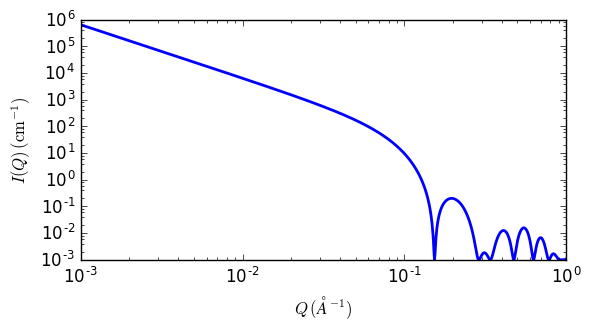lamellar_hg
Random lamellar phase with Head and Tail Groups
| Parameter | Description | Units | Default value |
|---|---|---|---|
| scale | Source intensity | None | 1 |
| background | Source background | cm-1 | 0.001 |
| length_tail | Tail thickness ( total = H+T+T+H) | Å | 15 |
| length_head | Head thickness | Å | 10 |
| sld | Tail scattering length density | 10-6Å-2 | 0.4 |
| sld_head | Head scattering length density | 10-6Å-2 | 3 |
| sld_solvent | Solvent scattering length density | 10-6Å-2 | 6 |
The returned value is scaled to units of cm-1 sr-1, absolute scale.
This model provides the scattering intensity, \(I(q)\), for a lyotropic lamellar phase where a random distribution in solution are assumed. The SLD of the head region is taken to be different from the SLD of the tail region.
Definition
The scattering intensity \(I(q)\) is
The form factor \(P(q)\) is
where \(\delta_T\) is length_tail, \(\delta_H\) is length_head, \(\Delta\rho_H\) is the head contrast (sld_head \(-\) sld_solvent), and \(\Delta\rho_T\) is tail contrast (sld \(-\) sld_solvent).
The total thickness of the lamellar sheet is \(\delta_H + \delta_T + \delta_T + \delta_H\). Note that in a non aqueous solvent the chemical “head” group may be the “Tail region” and vice-versa.
The 2D scattering intensity is calculated in the same way as 1D, where the \(q\) vector is defined as

Fig. 41 1D plot corresponding to the default parameters of the model.
References
F Nallet, R Laversanne, and D Roux, J. Phys. II France, 3, (1993) 487-502
also in J. Phys. Chem. B, 105, (2001) 11081-11088
2014/04/17 - Description reviewed by S King and P Butler.